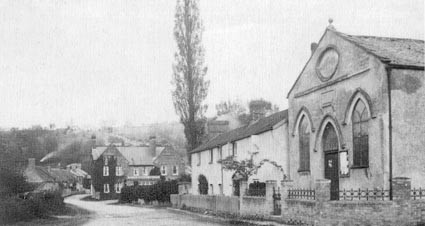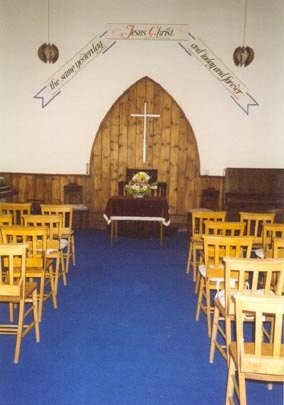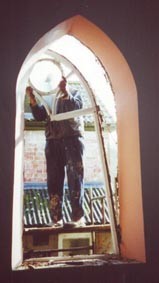





STOKE ST MARY AND DISTRICT HISTORY GROUP
HISTORY OF STOKE CHAPEL
TOP OF PAGE

HISTORY


STOKE ST MARY
CONGREGATIONAL CHAPEL
A Short History of Non-
in Stoke St Mary
by Tom Mayberry
It was to the sound of marching armies and the roar of guns that the nonconformist tradition was established in Stoke St Mary. The strong Puritan sentiments of the area, which, in about 1640, had prompted the Norman family of Orchard Portman to seek freedom of worship in America, were greatly strengthened by the sufferings of the Civil War. Following the Restoration of the Monarchy in 1660, it was natural, therefore, that Puritanism should quickly grow into active dissent from the Anglican Church.
A survey made in 1669 revealed that a group of ministers, ejected from their churches as non-
When as is believed, the Duke of Monmouth made his way through the village in 1685, it was an army of Presbyterians who followed him. From Stoke St Mary came five recruits, among them Daniel Manning, the blacksmith’s apprentice, but there were certainly many others in the village who supported Monmouth’s cause, as the aftermath of Sedgemoor in part revealed. William Doble’s daughter, Hannah, was accused of treason and waited until 1686 for a pardon, while Amy Gardner’s house was repeatedly searched by those attempting to capture her son a non-
From its high-
But not until the 19th century, in the wake of the Evangelical Revival fostered by John Wesley, did non-
Stoke Chapel owed its foundation to the Home Missionary Society, formed in 1819 to provide for the needs of ‘spiritually destitute places’. It was in consequence an addition to the village unlikely to commend itself to the Anglican curate of the day -
Men like George Weaver a labourer, were its early supporters and there is little doubt they met in large numbers. The Taunton Courier in 1848 reported a gathering held in the Chapel on behalf of its Sunday School when about 100 people were ’regaled with tea and cake’, and on another occasion in 1849 the congregation numbered almost 300. Following the service many went up into Stoke Woods and ’made the hills resound with their vocal choruses’.
With a Sunday congregation 100 in 1851, the Chapel was in flourishing condition when in 1853, it became a preaching station of the newly formed Taunton Village Evangelist Society. The Society’s preachers made a weekly journey to conduct the undenominational services, walking to the village in the summer months, in winter travelling with others of the congregation in a wagonette. In 1863 it was proposed that a day school be held in the Chapel and 3 years later Mr Peacock successfully reopened the Sunday School drawing good attendance both in the morning and afternoon . But the services themselves were languishing and by the end of 1866 the Chapel had been let to the Wesleyan Society of Taunton. It may even have been closed for a time.
It was in 1875 that the Chapel was taken once more into tire care of the Village Evangelist Society, and not until 1891 that thorough restoration set a seal on its reviving fortunes. The old oak pulpit was removed and its place taken by a rostrum, there were new brass lamps and a heating stove, new stone steps leading to the door, while around the Chapel a boundary wall was built, surmounted by an ornamental railing. With much celebration the Chapel was reopened on 20 August 1891.
The history of the Chapel in the 20th century has mirrored the struggles and successes of its past. A new Trust Deed drawn up in 1936 marked the beginning of a period of stability which has continued until today. But there have been many difficult tunes. Without faithful support of its trustees and congregation -
When in 1975 the Chapel celebrated its 150th Anniversary, it was the Anglican rector who led prayers at the service of thanksgiving. Old rivalries are at last forgotten and Stoke Chapel, like the parish church its neighbour, now finds a new place in a modem village.
Ken Coles was the minister from September 1984 to April 1993 and he built up a regular congregation of about 30. Many improvements were made to the chapel. New chairs replaced the ancient bench seats. The old Tortoise stove was replaced by modern heaters. £9,000 was spent on the new vestry, kitchen and toilet.

In the years that followed, the congregation dwindled. Yet new doors were kindly made and fitted by Mr Len Berry. The front of the building has been renewed and the old chimney removed. New carpet has been laid and this completes the welcoming appearance of the interior.
In 1996 the church joined the Congregational Federation. On 10th October 2004 Rev.Ray Avent was recognised as the minister.

We hope that the structural work has now been completed. The inside of the west wall has received attention and three windows have been replaced. Our purpose is that the worship of God may continue here, and that there will always be a welcome for men and women who want to hear the Word of God.